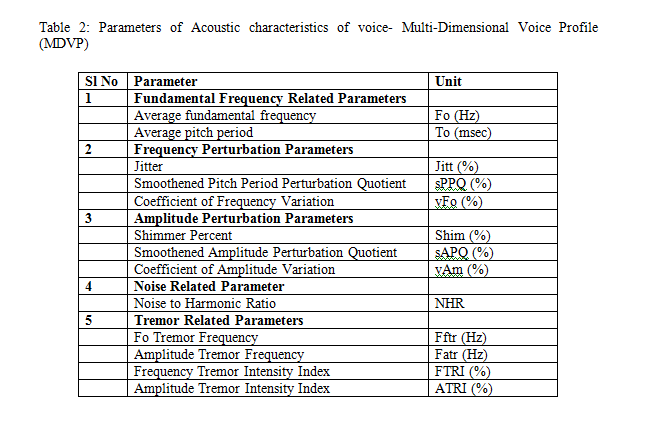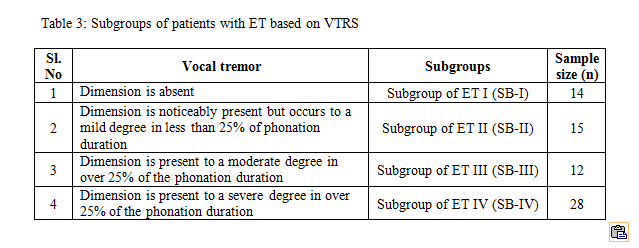Session Information
Date: Sunday, October 7, 2018
Session Title: Tremor
Session Time: 1:45pm-3:15pm
Location: Hall 3FG
Objective: To study the EGG characteristics and acoustic characteristics of voice in patients with ET(pET)
Background: Hyperkinetic voice disorder of ET is the resultant of tremor affecting structures within the speech mechanism, i.e., the respiratory, laryngeal, velopharyngeal, or oral region (Critchley, 1949). In the present study we attempt to understand the acoustic markers of voice and physiology behind voice quality in pET.
Methods: 138 subjects were recruited for the study with consent. Of them the study group comprised of 69 pET(G I). These patients were compared against age-gender matched 69 healthy individual subjects HI(G II). This is a matched case controlled retrospective study. In phase 1 of the study sustained phonation of vowel /i/ was recorded digitally and the voice parameters of EGG(Contact quotient[Table 1]) and Multidimensional Voice Protocol-MDVP(Fundamental frequency, Frequency perturbation, Amplitude Perturbation, Noise and Tremor[Table 2]) were extracted and analysed the sample using Computerized Speech Labs(CSL). In the phase 2 judgments on severity of vocal tremor was perceptually evaluated. This was carried out by group of 5 Speech Language Pathologists using Vocal Tremor Rating Scale(VTRS). Three out of five judgments of perceptual evaluation were considered to decide the subgroups of ET. The subgroups of the ET are SB-I,SB-II,SB-III and SB-IV(Table 3): Parameters of EGG and MDVP were computed and subjected to statistical analysis of Mann Whitney U-Test(Phase 1) and Kruskal Wallis Test(Phase 2).
Results: Phase 1: A.Significant difference was present(<0.05) between G I and G II for all the parameters of EGG and MDVP. Phase 2: A.Significant difference was present(<0.05) between G II and subgroups of ET(except for G II vs. SB-I) for the parameters of EGG and MDVP B.Significant difference was present (<0.05) between each subgroups of ET(except for SB-III vs. SB-IV) for the parameters of EGG and MDVP.
Conclusions: The findings of the current study suggest abnormality in phonation. Central Oscillatory Network dysfunction put forth in ET affecting distal musculature also affects the speech production. Therefore these affects can be attributed to involvement of mechanisms at both peripheral and central control i.e., multiple structures peripherally (intrinsic and extrinsic muscles of the larynx, palatal muscles, base of tongue, muscles of the diaphragm, chest wall, and abdomen(Louis 2010)) and centrally by laryngeal motor cortex (LMC) located in primary motor cortex.
References: 1. Duffy, J. R. (2013). Motor speech disorders: Substrates, differential diagnosis, and management. Elsevier Health Sciences. 2. Gamboa, J., Jimenez-Jimenez, F. J., Nieto, A., Cobeta, I., Vegas, A., Ortí-Pareja, M., et al., and Garcia-Albea, E. (1998). Acoustic voice analysis in patients with essential tremor. Journal of Voice, 12(4), 444-452.
To cite this abstract in AMA style:
P A. Shetty, B K. Yamini, R. Yadav, N. Shivashankar, PK. Pal. Electroglottographic(EGG) and Acoustic characteristics of voice in patients with Essential tremor(ET) [abstract]. Mov Disord. 2018; 33 (suppl 2). https://www.mdsabstracts.org/abstract/electroglottographicegg-and-acoustic-characteristics-of-voice-in-patients-with-essential-tremoret/. Accessed December 29, 2025.« Back to 2018 International Congress
MDS Abstracts - https://www.mdsabstracts.org/abstract/electroglottographicegg-and-acoustic-characteristics-of-voice-in-patients-with-essential-tremoret/



